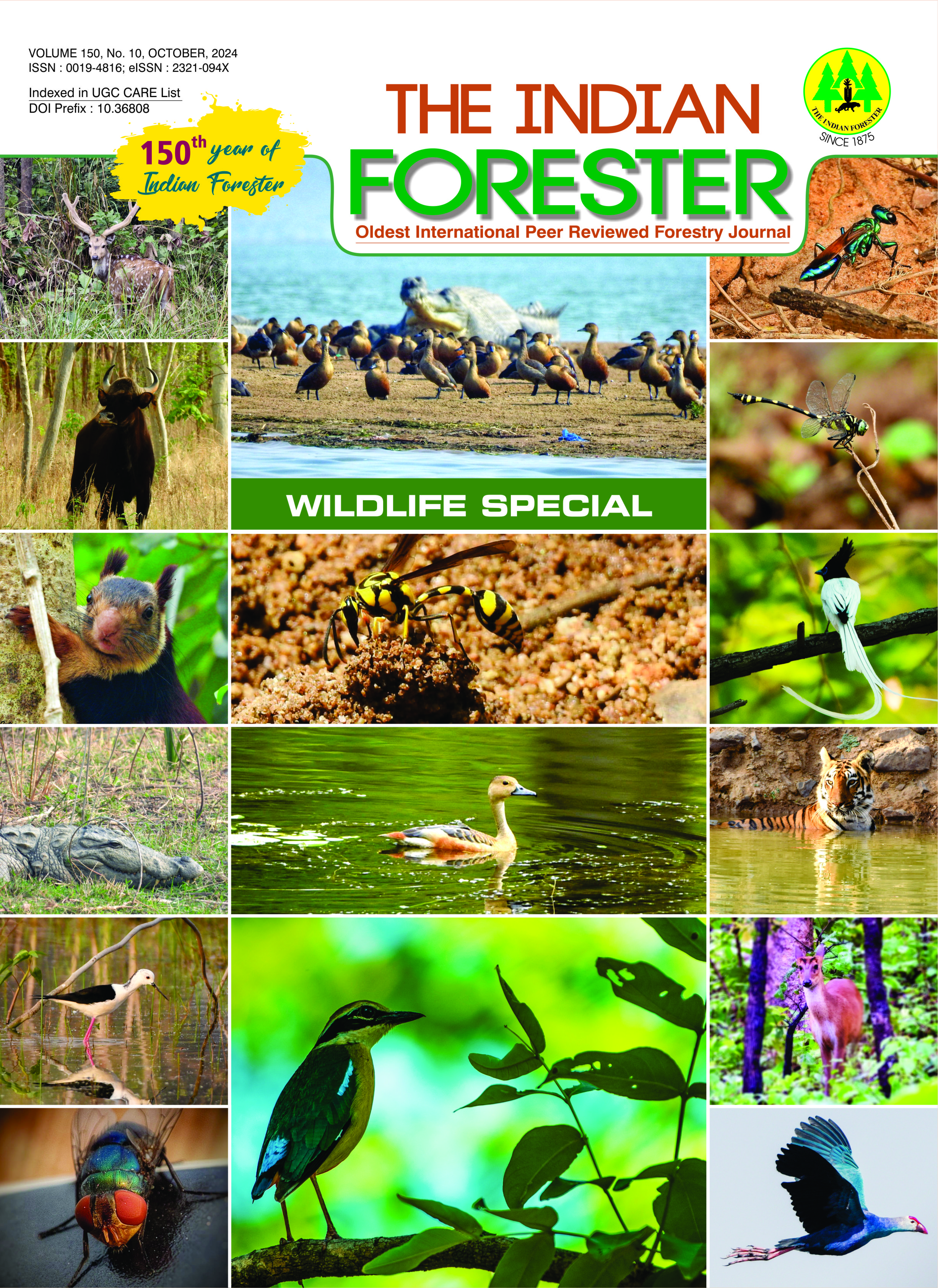A Tale of Agony of Spiny-Tailed Lizard: Conservation, Poaching and Trade Dynamics in Western Rajasthan, India
DOI:
https://doi.org/10.36808/if/2024/v150i10/169907Keywords:
Indian Spiny-Tailed Lizard, Poaching, Trade, Conservation.Abstract
The Indian spiny-tailed lizard, Saara hardwickii (Gray, 1827) is a key stone species of the desert ecosystem, many raptors and meso-carnivores like foxes and small cats feed on these lizards. A study to understand the level of poaching, its hot spots and ultimately to find out the trade route from study area to the rest of country, was conducted between January to June 2019. Field surveys, semi-structured interviews of locals, few former poachers and expert interviews were conducted to understand its current population distribution, poaching hot spots and probable trade route from Rajasthan to the rest of country. It was found that despite stringent laws poaching is still rampant for meat as well as extraction of oil from its reserve fat glands. This oil is believed to be aphrodisiac in nature and is major cause of its population decline. Recently this species has been upgraded from Schedule II (Part I) of Wildlife (Protection) Act, 1972 to Schedule I; as well as also from Data Deficient to Vulnerable in Red List of IUCN. Such level of changes in the protection status to this species will surely prove a millstone in its conservation efforts.References
Barbara K.Z. and M. Zain-ul-Abedin (1967).Characterization of the abdominal fat pads of a lizard. Comparative Biochemistry and Physiology, 23(1): 173-177.
Bhatnagar R.R., Bhanotar R.K., Srivastava Y.N. and Mahto Y. (1973 a). Preliminary studies on locust hopper predation by Uromastix hardwickii Gray. Entomologists' Newsletter, 3: 19-20.
Blanford W.T. (1874). Descriptions of new Reptilia and Amphibia from Persia and Baluchistan. Ibid, 14(4): 31-35.
D'Cruze N. Singh B., Mookerjee A., Harrington L.A. and Macdonald D.W. (2018). A socio-economic survey of pangolin hunting in Assam, Northeast India. Nature Conservation, 30: 83–105.
Das S.K. and Pandey V. (2005). Food, feeding behavior and habitat preference of spiny-tailed lizard (Uromastix hardwicki Gray 1827) in Thar Desert of Rajasthan, India. Tiger Paper, 32(4): 30-32.
Das S.K., Dookia S., Das K. and Dutta S.K. (2013). Ecological observations on the Indian Spiny-tailed Lizard Saarahardwickii (Gray, 1827) (Reptilia: Squamata: Agamidae) in Tal Chhapar Wildlife Sanctuary, Rajasthan, India. Journal of Threatened Taxa, 5: 3516–3526.
Das S.K., Joshi M. and Sahoo S. (2015). On the population status of Indian spiny-tailed lizard, Saara hardwickii outside the Thar Desert of Rajasthan, with a preliminary report on the herpeto fauna of Sariska National Park. Herpetology Notes, 8(3): 51–54.
Dutta S. and Jhala Y. (2007). Ecological Aspects of Indian Spiny-Tailed Lizard Uromastyx hardwickiiin Kutch. Journal of the Bombay Natural History Society, 104(3): 255–265.
Gray J.E. (1827). Uromastix [sic] hardwickii. Zoological Joumal, 3: 219
Grzimek B., Hutchings M., Schlager N. and Olendorf D. (2003). Grzimek's Animal Life Encyclopedia, Vol.7: Reptiles. In M. Hutchins, J.B. Murphy and N. Schlager (Eds.), Grzimek's Animal Life Encyclopedia (2nd ed., p. 48). Thomson Gale.
Kaur M., Joshi M.., Asrafuzzaman S. and Das S. (2020). Population status, habitat suitability and threat assessment of Indian spiny-tailed lizard Saara hardwickii (Gray, 1827) in the Thar desert of Rajasthan. Journal of Wildlife and Biodiversity, 4(3): 80–90. https://doi.org/10.22120/jwb.2020.122080.1120
Knapp A. (2004). An assessment of the international trade in spiny-tailed lizards Uromastyxwith a focus on the role of the European Union. TRAFFIC Europe, 13: 1–29.
Molur S. and Walker S. (1998). Report of the Workshop 'Conservation Assessment and Management Plan for Reptiles of India' (BCCP-Endangered Species Project). Conservation Breeding Specialist Group, Zoo Outreach Organisation, Coimbatore, India, 156.
Purves E.H. (1915). The Thorny-tailed Lizard. Journal of the Bombay Natural History Society, 23: 780–785.
Ramesh M. and Ishwar N.M. (2008). Status and distribution of the Indian spiny-tailed lizard Uromastyx hardwickii in the Thar Desert, western Rajasthan. Technical Report No T02, Group for Nature Preservation & Education, India, 48.
Sinha R.K., Bhatia S. and Vishnoi R. (1996). Desertification control and rangeland management in the Thar desert of India. RALAReport No. 200: 115–123.
Srivastava D.P., Chauhan A.S. and Ahlawat R. (2018). Indian Spiny-tailed Lizard: First record of Saara Hardwickii (Gray, 1827) in south-western Hisar District of Haryana, India. Reptile Rap #187.In: Zoo's Print, 33(10): 09-14.
Smith M.A. (1935). Reptilia and Amphibia. Vol. II- Sauria. In R. B. S. Sewell (Ed.), The Fauna of British India, Including st Ceylon And Burma. (1 Ed., pp. 242-247). London: Francis &Taylor.
Vyas R. (1991). Notes on capture of the Spiny-tailed Lizard (Uromastyx hardwickii) in Gujarat. Hamadryad, 15: 28.
Vyas R., Mohapatra P. and Papenfuss T. (2022). Saara hardwickii (amended version of 2021 assessment). The IUCN Red List of Threatened Species 2022: e.T199817A216173870. https://dx.doi.org/10.2305/IUCN.UK.2022-1.RLTS.T199817A216173870.en. Accessed on 20 April 2023.
Wilms T.M., Bohme W., Wagner P., Lutzmann N. and Schmitz A. (2009). On the Phylogeny and Taxonomy of the Genus Uromastyx Merrem, 1820 (Reptilia: Squamata: Agamidae: Uromastycinae) – Resurrection of the Genus Saara Gray, 1845. Bonner Zoologische Beiträge, 56(2007): 55–99.
Downloads
Downloads
Published
How to Cite
Issue
Section
License
Unless otherwise stated, copyright or similar rights in all materials presented on the site, including graphical images, are owned by Indian Forester.





